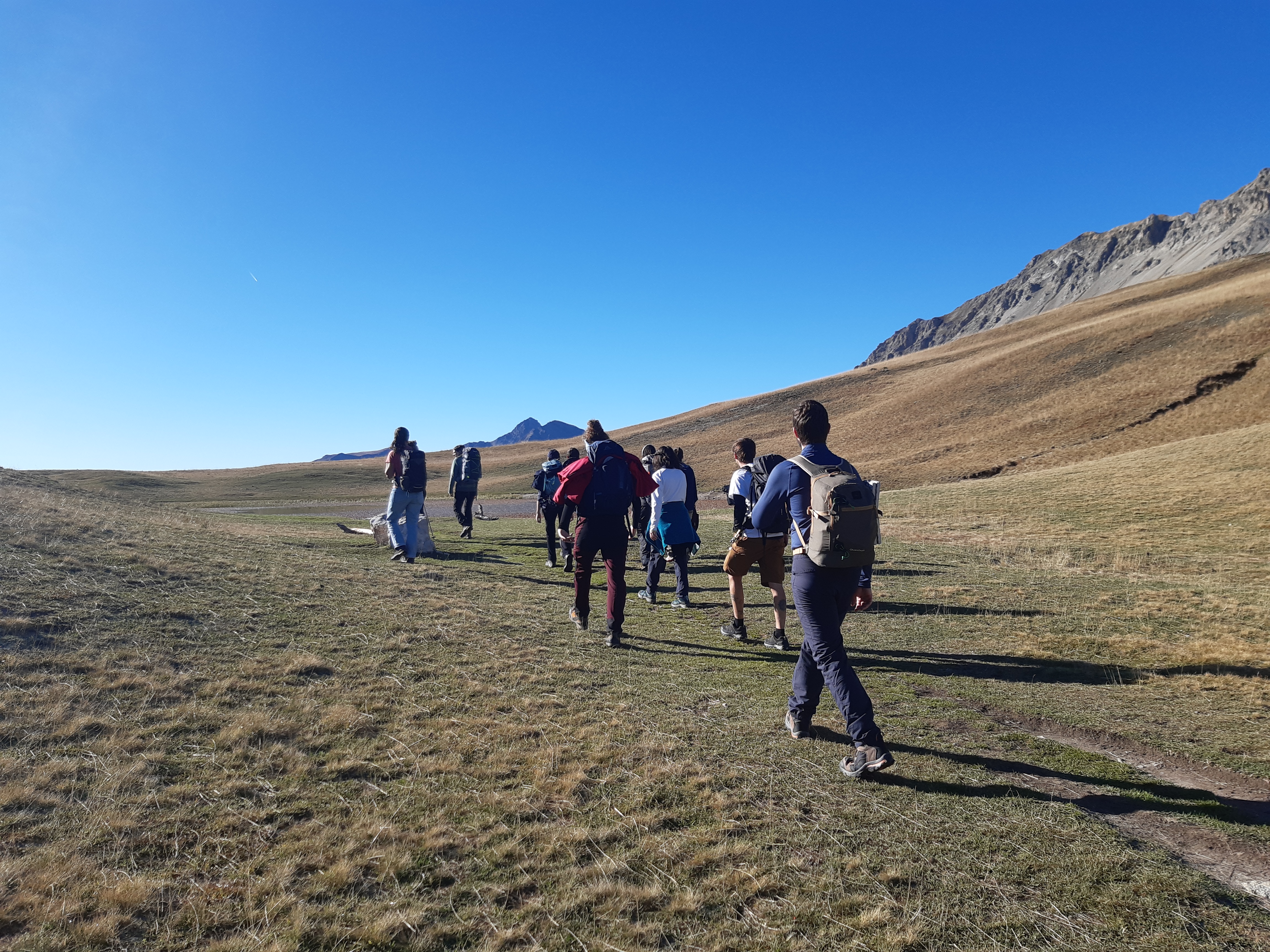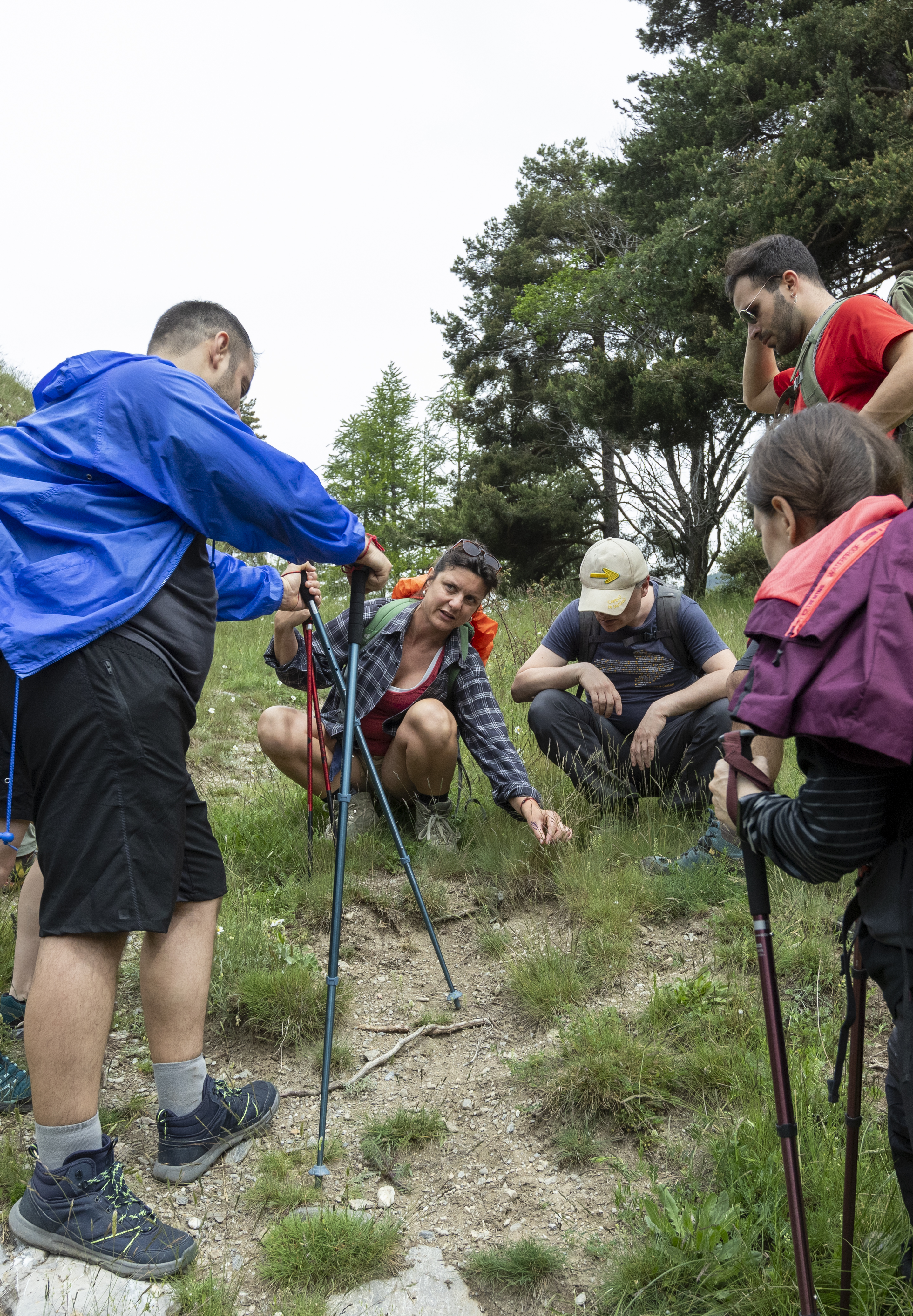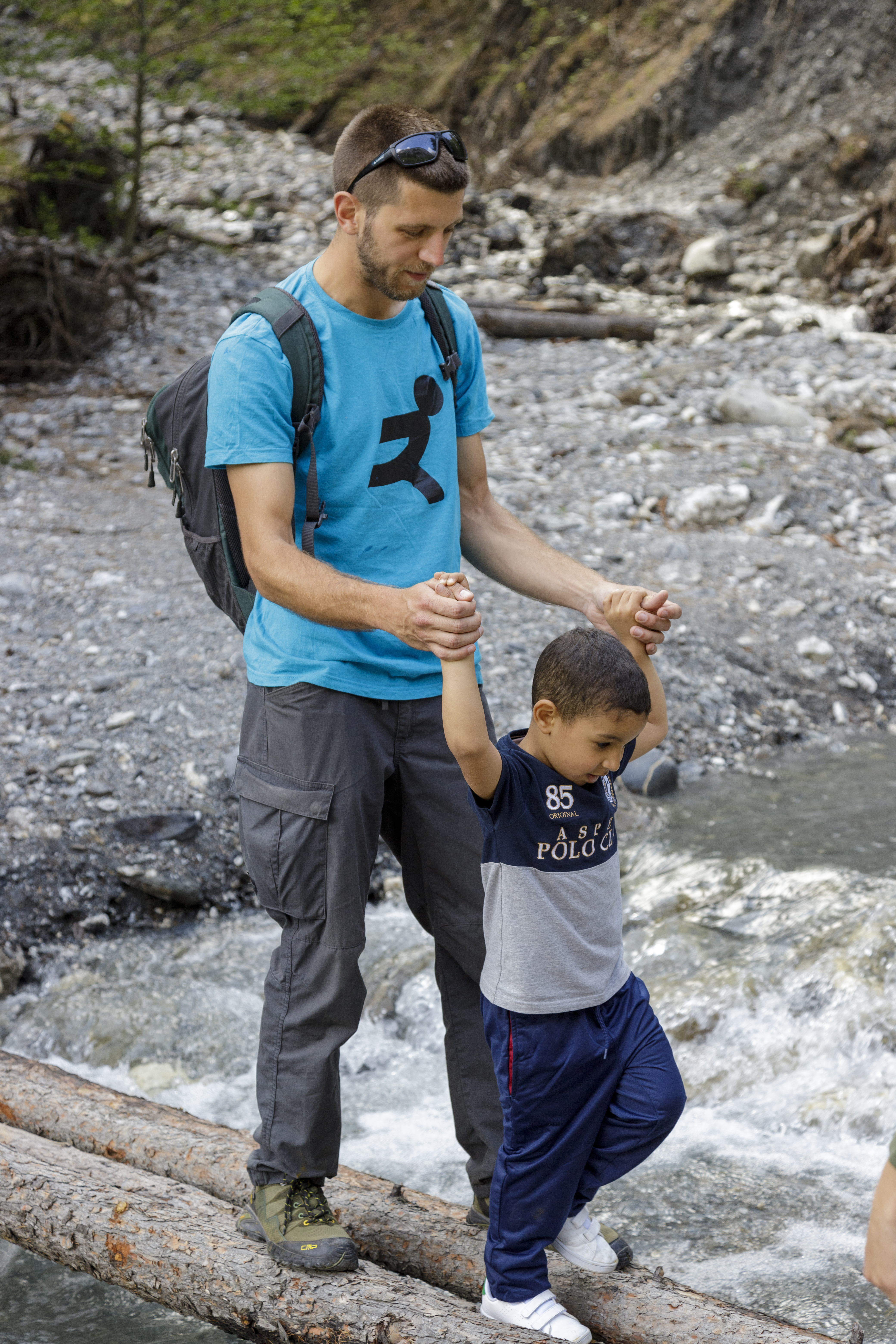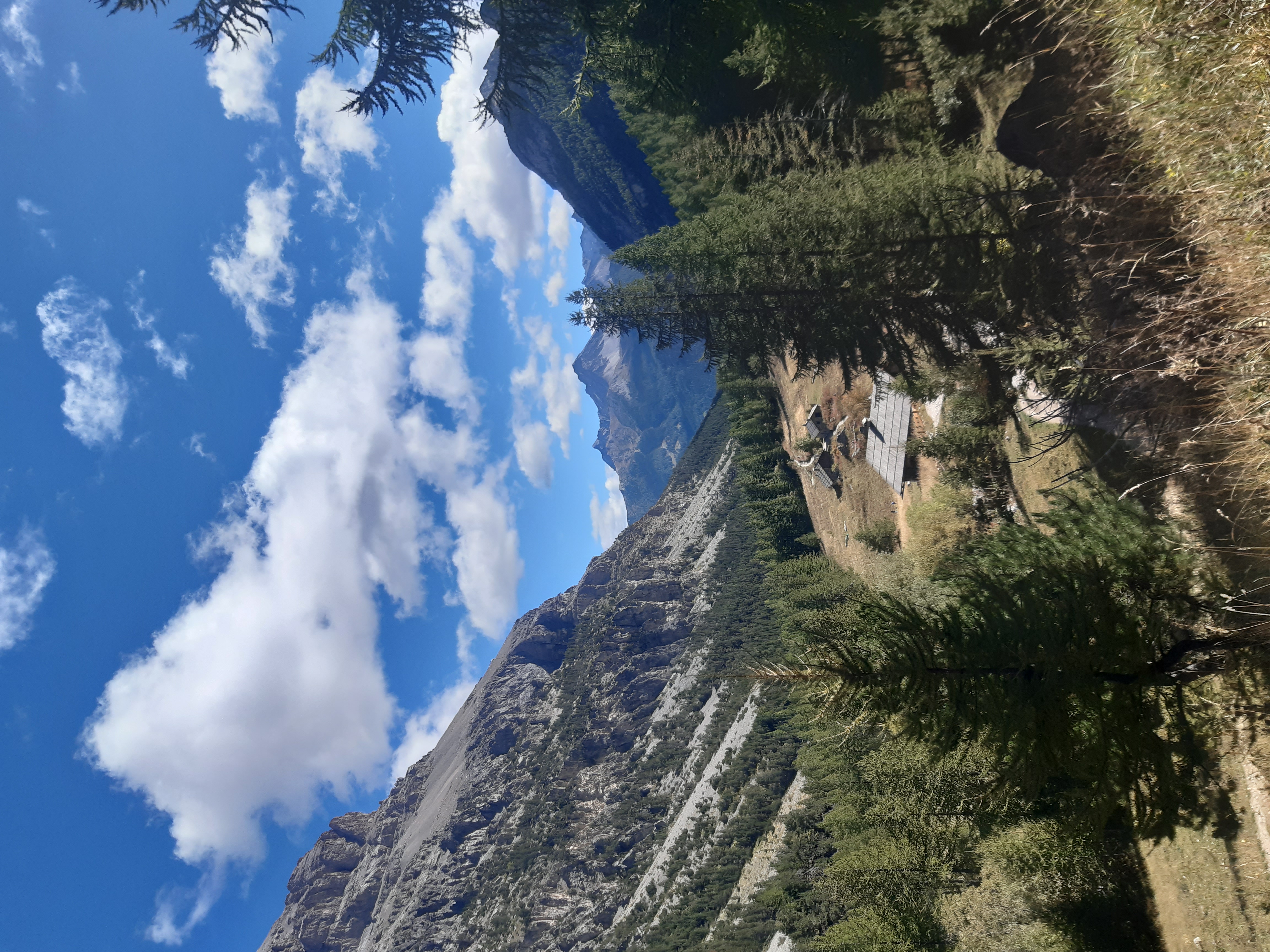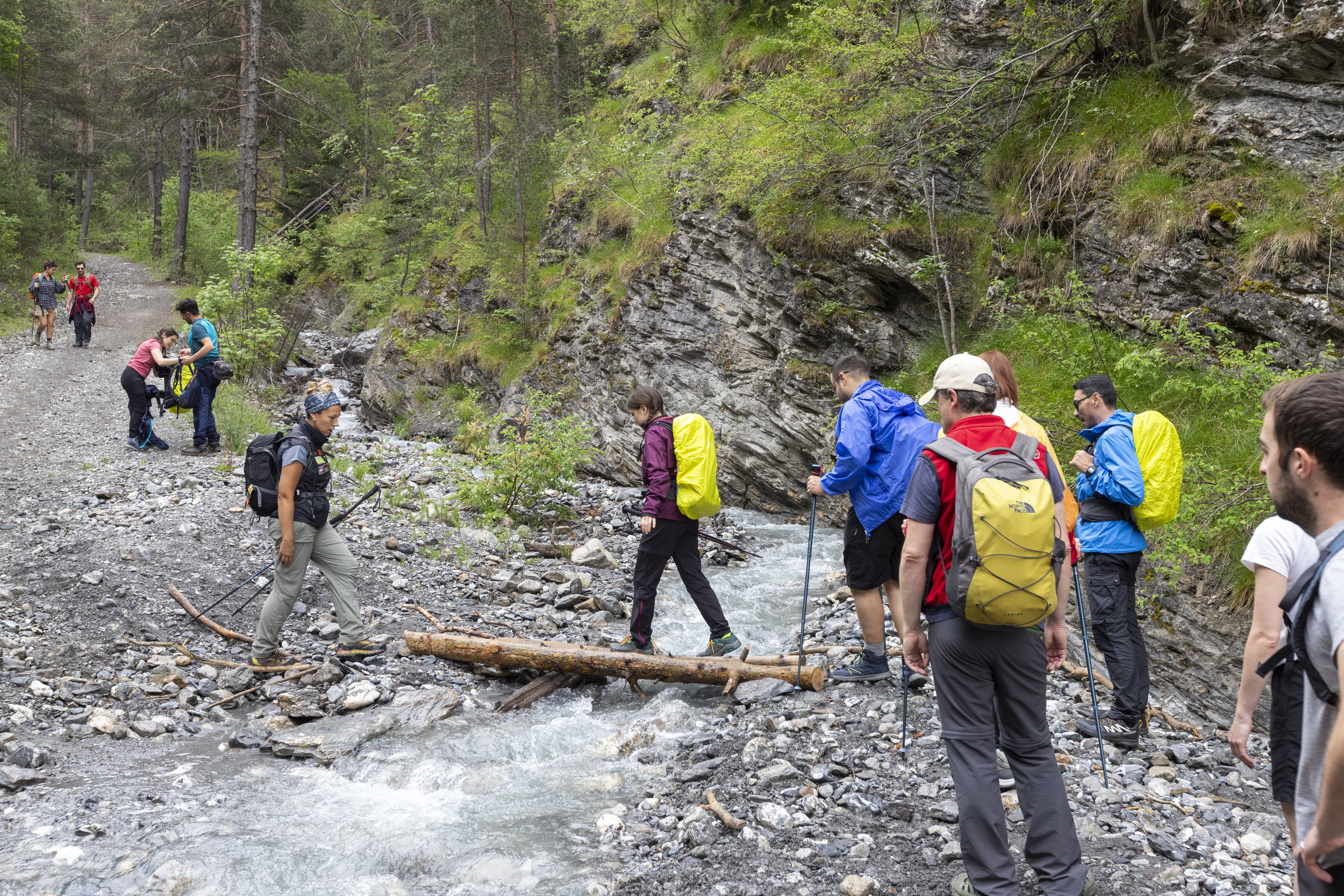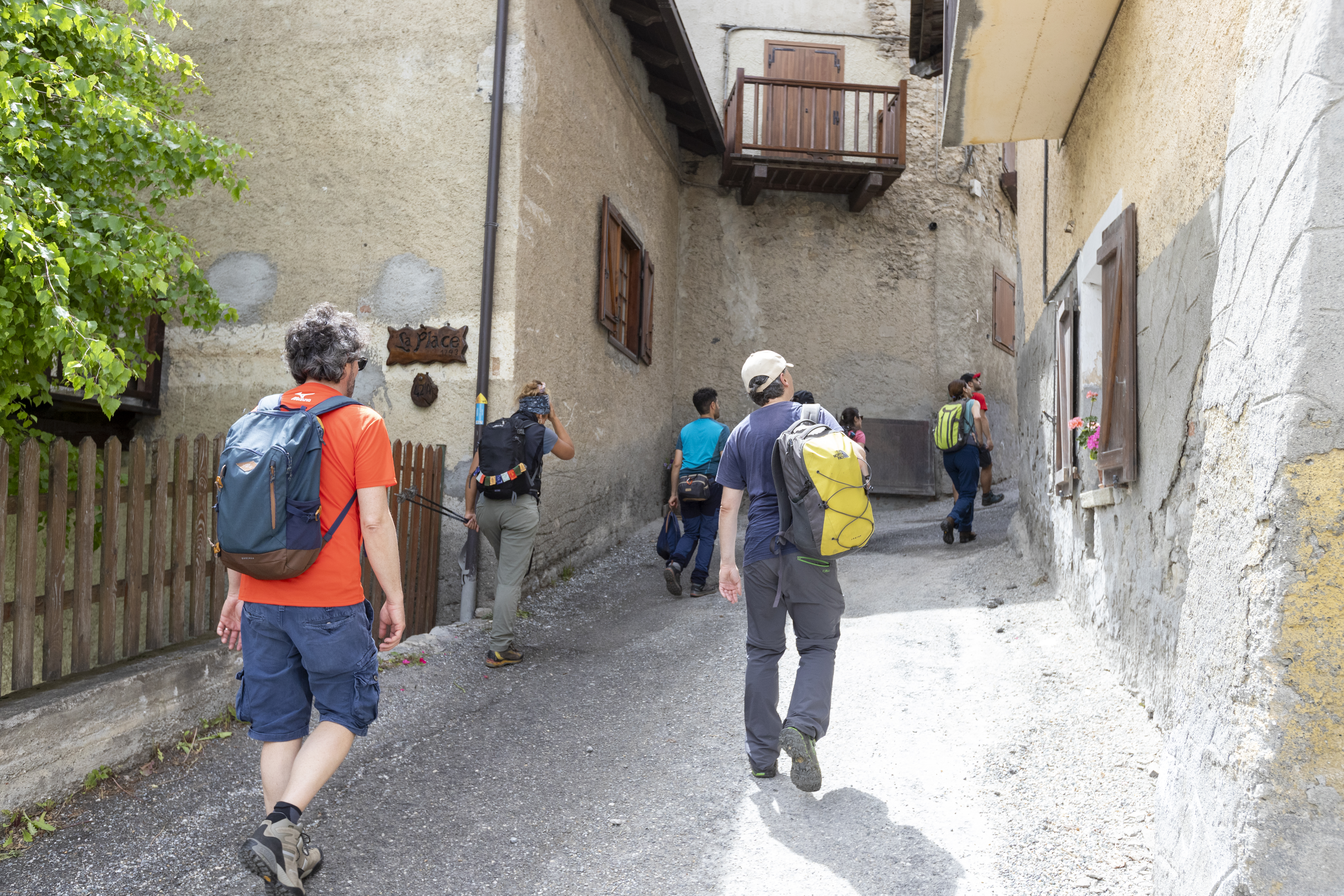Reconnecting with nature
The Sustainable Hiker’s Guide
The Sustainable Hiker’s Guide
The Sustainable Hiker’s Guide makes nature accessible to all: no car needed! By mapping accessible hiking routes near Turin reachable by public transport, we make outdoor adventures sustainable, inclusive, and affordable for all. Designed for families, students, and diverse communities, the project removes economic and social barriers to nature. Through guided walks and environmental education, we promote eco-friendly mobility and the right for everyone to explore the outdoors!
Italy
Regional
Piedmont region, Italy
It addresses urban-rural linkages
It refers to other types of transformations (soft investment)
Yes
2024-10-07
No
No
No
As a representative of an organisation
The Sustainable Hiker’s Guide was created to bridge the gap between urban communities and the natural environment, especially for people who cannot or do not want to use a private car for trips outside the city.
It began with a simple request by two mothers living in a social housing neighborhood: “Can you help us to organize a mountain trip?”. This simple question hides a huge problem that affects inner areas in Italy: accessibility and daily mobility in mountain areas. If you need to move between urban areas and inland areas for study, work, or leisure, it is very difficult to do so using public transportation.
So what started as a response to this request quickly grew into a larger initiative to make the natural environment accessible to everyone. Students, families, and individuals joined in, all eager to experience the outdoors without needing a private car. We mapped the hilly and mountainous areas around Turin that can be reached by public transportation (buses or trains), and we selected destinations that can be reached with a journey lasting no more than two hours to allow for a day trip. Afterwards, we organized 10 guided walks led by nature guides with a deep knowledge about wilderness and local flora and fauna, as well as the customs and traditions of the area.
Following these experiences, we wrote and curated The Sustainable Hiker’s Guide, now available for free in digital format in both English and Italian, downloadable from our website.
More than just a collection of itineraries, this guide is a bridge between the city and inner natural areas, an invitation to reconnect with the natural environment without barriers or exclusions. Because the right to explore, to well-being, and to adventure belongs to everyone.
By making nature truly accessible, we are reshaping the way urban communities engage with the natural world, one hike at a time!
It began with a simple request by two mothers living in a social housing neighborhood: “Can you help us to organize a mountain trip?”. This simple question hides a huge problem that affects inner areas in Italy: accessibility and daily mobility in mountain areas. If you need to move between urban areas and inland areas for study, work, or leisure, it is very difficult to do so using public transportation.
So what started as a response to this request quickly grew into a larger initiative to make the natural environment accessible to everyone. Students, families, and individuals joined in, all eager to experience the outdoors without needing a private car. We mapped the hilly and mountainous areas around Turin that can be reached by public transportation (buses or trains), and we selected destinations that can be reached with a journey lasting no more than two hours to allow for a day trip. Afterwards, we organized 10 guided walks led by nature guides with a deep knowledge about wilderness and local flora and fauna, as well as the customs and traditions of the area.
Following these experiences, we wrote and curated The Sustainable Hiker’s Guide, now available for free in digital format in both English and Italian, downloadable from our website.
More than just a collection of itineraries, this guide is a bridge between the city and inner natural areas, an invitation to reconnect with the natural environment without barriers or exclusions. Because the right to explore, to well-being, and to adventure belongs to everyone.
By making nature truly accessible, we are reshaping the way urban communities engage with the natural world, one hike at a time!
Nature
Accessibility
Sustainability
Inclusion
Mobility
Our project embraces sustainability through three key objectives:
1. Promoting sustainable mobility
In Italy, 58% of the national territory consists of inner areas characterized by a lack of essential services. One of the emerging issues is the poor accessibility, both for those who live in these areas for those who want to visit them without using a private car. This project responds to this need, mapping the areas that can already be reached with public transport and promoting their use.
By demonstrating that natural areas can be reached sustainably, we provide participants with a replicable model for low-impact travel. This approach reduces emissions, minimizes ecological footprints, and makes outdoor experiences more inclusive for those who do not own a car; it also encourages a cultural shift toward viewing public transport as a viable and responsible way to explore nature.
2. Promoting the concept of Metro-Mountain
One of the main goals is to change the idea that urban areas and mountain environments are separate and independent. Instead, the project promotes the concept of Metro-Mountain, which recognizes the close connection and interdependence between cities and their surrounding natural territories. This shift in perspective encourages people to see nature not as something distant but as an integral part of their everyday lives. By fostering this awareness, we aim to strengthen the bond between urban communities and the ecosystems that sustain them, ultimately promoting a more responsible and engaged relationship with the natural environment.
3. Enhancing environmental awareness
The hikers using the guide have the opportunity to observe natural environments thanks to the content provided by the nature guides involved in the project.
1. Promoting sustainable mobility
In Italy, 58% of the national territory consists of inner areas characterized by a lack of essential services. One of the emerging issues is the poor accessibility, both for those who live in these areas for those who want to visit them without using a private car. This project responds to this need, mapping the areas that can already be reached with public transport and promoting their use.
By demonstrating that natural areas can be reached sustainably, we provide participants with a replicable model for low-impact travel. This approach reduces emissions, minimizes ecological footprints, and makes outdoor experiences more inclusive for those who do not own a car; it also encourages a cultural shift toward viewing public transport as a viable and responsible way to explore nature.
2. Promoting the concept of Metro-Mountain
One of the main goals is to change the idea that urban areas and mountain environments are separate and independent. Instead, the project promotes the concept of Metro-Mountain, which recognizes the close connection and interdependence between cities and their surrounding natural territories. This shift in perspective encourages people to see nature not as something distant but as an integral part of their everyday lives. By fostering this awareness, we aim to strengthen the bond between urban communities and the ecosystems that sustain them, ultimately promoting a more responsible and engaged relationship with the natural environment.
3. Enhancing environmental awareness
The hikers using the guide have the opportunity to observe natural environments thanks to the content provided by the nature guides involved in the project.
The Sustainable Hiker’s Guide aims to promote an experience that is both aesthetically pleasing and culturally enriching, with a strong emphasis on sustainability. The guide aims to raise hikers' awareness of the landscape and cultural value of the places in the Turin metro-mountain area.
In particular the Guide is based on five main pillars:
Aesthetic Design: The Guide is designed to be easily usable by everyone and visually appealing. The graphic layout has been designed to evoke the idea of harmony with the natural environment. In this sense, natural beauty is an integral part of the hiking experience.
Cultural Experience: the Guide highlights not only the natural aspects but also the cultural and historical significance of the territories. This helps hikers understand and appreciate the history of the regions they explore. In this way, the experience becomes enriched with added value that goes beyond physical activity and scenic beauty.
Quality of Experience: the Guide aims to ensure that hikers can fully enjoy the places in an immersive way, in heterogeneous groups that foster interaction and exchange between people, creating awareness of the places they traverse and a sense of attachment to them.
Environmental Sustainability: the Guide helps to limit the phenomenon of over tourism in the most visited natural areas by increasing the offer towards ecologically valuable but lesser-known areas.
Education and Awareness: the Guide also serves as an educational tool that promotes environmental and cultural awareness among hikers. In this way, the project can serve as an example for other initiatives that combine design, aesthetics, and culture sustainably.
In particular the Guide is based on five main pillars:
Aesthetic Design: The Guide is designed to be easily usable by everyone and visually appealing. The graphic layout has been designed to evoke the idea of harmony with the natural environment. In this sense, natural beauty is an integral part of the hiking experience.
Cultural Experience: the Guide highlights not only the natural aspects but also the cultural and historical significance of the territories. This helps hikers understand and appreciate the history of the regions they explore. In this way, the experience becomes enriched with added value that goes beyond physical activity and scenic beauty.
Quality of Experience: the Guide aims to ensure that hikers can fully enjoy the places in an immersive way, in heterogeneous groups that foster interaction and exchange between people, creating awareness of the places they traverse and a sense of attachment to them.
Environmental Sustainability: the Guide helps to limit the phenomenon of over tourism in the most visited natural areas by increasing the offer towards ecologically valuable but lesser-known areas.
Education and Awareness: the Guide also serves as an educational tool that promotes environmental and cultural awareness among hikers. In this way, the project can serve as an example for other initiatives that combine design, aesthetics, and culture sustainably.
The project places inclusion at its core, ensuring that outdoor experiences and nature exploration are accessible, affordable, and welcoming to all. It was born from the association’s long-standing presence in a social housing neighborhood in Turin, where we have been carrying out urban and cultural regeneration projects. Over time, residents expressed a desire for organized mountain excursions, revealing how many natural destinations around the city were perceived as exclusive or difficult to access.
A key objective has been removing economic barriers, ensuring that nature can be explored also by economically disadvantaged people. Beyond cost, the project also sought to address cultural and social barriers that can make mountain environments feel distant or intimidating, particularly for those who did not grow up in the region. Even locals often lack knowledge of the mountains if their families never introduced them to this ecosystem. The project aimed to bridge this gap by providing expert guides who not only facilitated participation but also empowered individuals with the confidence and skills to explore independently.
Another core goal was to create heterogeneous and inclusive groups, bringing together people of different ages, cultures, and social backgrounds: an opportunity for exchange and learning.
To ensure long-term impact and replicability, the Sustainable Hiker’s Guide provides open access to all documented trails, complete with directions and public transport options. This comprehensive resource addresses the lack of an integrated information system in our region concerning transportation links between cities and valleys. By consolidating details from various service providers, the guide eliminates barriers for individuals unfamiliar with digital tools, Italian language, or people who are simply unaware of the existence of different companies of public transportation.
A key objective has been removing economic barriers, ensuring that nature can be explored also by economically disadvantaged people. Beyond cost, the project also sought to address cultural and social barriers that can make mountain environments feel distant or intimidating, particularly for those who did not grow up in the region. Even locals often lack knowledge of the mountains if their families never introduced them to this ecosystem. The project aimed to bridge this gap by providing expert guides who not only facilitated participation but also empowered individuals with the confidence and skills to explore independently.
Another core goal was to create heterogeneous and inclusive groups, bringing together people of different ages, cultures, and social backgrounds: an opportunity for exchange and learning.
To ensure long-term impact and replicability, the Sustainable Hiker’s Guide provides open access to all documented trails, complete with directions and public transport options. This comprehensive resource addresses the lack of an integrated information system in our region concerning transportation links between cities and valleys. By consolidating details from various service providers, the guide eliminates barriers for individuals unfamiliar with digital tools, Italian language, or people who are simply unaware of the existence of different companies of public transportation.
The project was deeply rooted in community involvement from its inception, ensuring that the people benefiting from it were also active contributors to its development.
It started in the social housing complex of Via Arquata in Turin, where our work in urban and cultural regeneration revealed an interest among residents in accessing the surrounding natural areas. Rather than being passive participants, they played a role in co-design the initiative. For example, logistical decisions, such as selecting the most suitable day for the outings, were made in direct consultation with local families: while Saturday initially seemed like the best choice, feedback from residents highlighted that many children attended Arabic school that day, leading to adjustments in scheduling. Beyond these practical contributions, participants also provided feedback after each excursion, helping to refine the experience.
One of the impacts of this involvement has been the creation of new social connections. While the project was initially co-designed with a specific neighborhood, the excursions brought together a diverse range of participants, including out-of-town students, families from other districts, and individuals with different backgrounds. This mix fostered an inclusive environment where people who might not otherwise interact had the chance to share experiences. For many residents, who often feel socially segregated due to economic and cultural barriers, the opportunity to engage with a broader community was particularly meaningful.
In addition to this, all participants had the opportunity to learn about local ecosystems, responsible hiking practices, and how to navigate and appreciate mountains.
It started in the social housing complex of Via Arquata in Turin, where our work in urban and cultural regeneration revealed an interest among residents in accessing the surrounding natural areas. Rather than being passive participants, they played a role in co-design the initiative. For example, logistical decisions, such as selecting the most suitable day for the outings, were made in direct consultation with local families: while Saturday initially seemed like the best choice, feedback from residents highlighted that many children attended Arabic school that day, leading to adjustments in scheduling. Beyond these practical contributions, participants also provided feedback after each excursion, helping to refine the experience.
One of the impacts of this involvement has been the creation of new social connections. While the project was initially co-designed with a specific neighborhood, the excursions brought together a diverse range of participants, including out-of-town students, families from other districts, and individuals with different backgrounds. This mix fostered an inclusive environment where people who might not otherwise interact had the chance to share experiences. For many residents, who often feel socially segregated due to economic and cultural barriers, the opportunity to engage with a broader community was particularly meaningful.
In addition to this, all participants had the opportunity to learn about local ecosystems, responsible hiking practices, and how to navigate and appreciate mountains.
The project was developed through the collaboration of various stakeholders at different levels.
At the local level, the Agenzia per lo Sviluppo di San Salvario, which manages the community hub of San Salvario District, played a key role in communication and community engagement. They helped spread the word about the initiative, encouraged participation, and provided spaces for meetings and events, making the project more accessible to a wider audience.
At the regional level, journalist and writer Maurizio Dematteis, director of the web magazine Dislivelli.eu, contributed his expertise on the concept of Metro-Mountain. He collaborated with us in shaping the project’s narrative and co-organized a public talk on these themes. Additionally, our environmental hiking guides, Giulia Cerrato and Martina Cerutti, who are part of RIFAI (the Italian Network of Young Facilitators of Inner Areas), were instrumental in selecting, designing, and enriching the itineraries. Their contribution included storytelling and educational insights into the local environment, making the excursions more engaging and informative.
At the European level, the International Commission for the Protection of the Alps (CIPRA) enhanced the project by organizing a two-day hiking experience for participants under 30, including an overnight stay in a mountain refuge. This special excursion introduced young people to the Via Alpina and featured an interactive workshop on accessibility in mountain environments. With all expenses covered, the initiative ensured that young participants could take part regardless of financial constraints, fostering greater inclusion and exchange on a transnational scale.
After the publication of the Sustainable Hiker’s Guide, the city administration also became involved. We were invited by the City’s Mobility Department to present our work and discuss how it could contribute to the city’s broader efforts in promoting sustainable mobility.
At the local level, the Agenzia per lo Sviluppo di San Salvario, which manages the community hub of San Salvario District, played a key role in communication and community engagement. They helped spread the word about the initiative, encouraged participation, and provided spaces for meetings and events, making the project more accessible to a wider audience.
At the regional level, journalist and writer Maurizio Dematteis, director of the web magazine Dislivelli.eu, contributed his expertise on the concept of Metro-Mountain. He collaborated with us in shaping the project’s narrative and co-organized a public talk on these themes. Additionally, our environmental hiking guides, Giulia Cerrato and Martina Cerutti, who are part of RIFAI (the Italian Network of Young Facilitators of Inner Areas), were instrumental in selecting, designing, and enriching the itineraries. Their contribution included storytelling and educational insights into the local environment, making the excursions more engaging and informative.
At the European level, the International Commission for the Protection of the Alps (CIPRA) enhanced the project by organizing a two-day hiking experience for participants under 30, including an overnight stay in a mountain refuge. This special excursion introduced young people to the Via Alpina and featured an interactive workshop on accessibility in mountain environments. With all expenses covered, the initiative ensured that young participants could take part regardless of financial constraints, fostering greater inclusion and exchange on a transnational scale.
After the publication of the Sustainable Hiker’s Guide, the city administration also became involved. We were invited by the City’s Mobility Department to present our work and discuss how it could contribute to the city’s broader efforts in promoting sustainable mobility.
The project brings together multiple disciplines, creating a transdisciplinary approach: professionals specializing in participatory planning, anthropology, geography, design, graphic arts, and environmental guidance contributed to the project's implementation.
A key methodological pillar was community engagement and participatory processes: a Human-Centered Design process was implemented starting by the real desires and needs of the residents of Via Arquata neighborhood. This participatory approach, rooted in social sciences, guaranteed that outdoor activities were not only accessible but also meaningful in fostering social inclusion.
From a highly transdisciplinary perspective, the project introduced and applied the concept of Metro-Mountain, which encompasses aspects of geography, sociology, anthropology, and environmental studies. This approach highlights the deep interconnection between urban and mountain environments, not only in terms of physical space but also through social, economic, and cultural relationships.
As for the trails, environmental sciences and alpine studies characterized the project's educational approach, with expert guides providing environmental education during excursions.
The project also aligned with principles of environmental justice, recognizing that access to nature and participation in climate action should not be privileges reserved for a few. Too often, outdoor recreation and ecological awareness remain inaccessible due to financial, cultural, or logistical barriers. By removing these obstacles, the project demonstrated that environmental responsibility and the fight against climate change must be collective efforts that involve everyone.
Additionally, the project incorporated design and editorial disciplines in the creation of the Sustainable Hiker’s Guide: this guide was designed to be visually accessible and user-friendly, ensuring that knowledge could be easily disseminated and replicated in other contexts.
A key methodological pillar was community engagement and participatory processes: a Human-Centered Design process was implemented starting by the real desires and needs of the residents of Via Arquata neighborhood. This participatory approach, rooted in social sciences, guaranteed that outdoor activities were not only accessible but also meaningful in fostering social inclusion.
From a highly transdisciplinary perspective, the project introduced and applied the concept of Metro-Mountain, which encompasses aspects of geography, sociology, anthropology, and environmental studies. This approach highlights the deep interconnection between urban and mountain environments, not only in terms of physical space but also through social, economic, and cultural relationships.
As for the trails, environmental sciences and alpine studies characterized the project's educational approach, with expert guides providing environmental education during excursions.
The project also aligned with principles of environmental justice, recognizing that access to nature and participation in climate action should not be privileges reserved for a few. Too often, outdoor recreation and ecological awareness remain inaccessible due to financial, cultural, or logistical barriers. By removing these obstacles, the project demonstrated that environmental responsibility and the fight against climate change must be collective efforts that involve everyone.
Additionally, the project incorporated design and editorial disciplines in the creation of the Sustainable Hiker’s Guide: this guide was designed to be visually accessible and user-friendly, ensuring that knowledge could be easily disseminated and replicated in other contexts.
The innovative character of the project lies in its ability to challenge traditional models of outdoor recreation, making nature accessible, inclusive, and sustainable for all.
The project is inspired by the One Health approach, recognizing the close interconnection between human health, animal health, and the health of ecosystems. Promoting the sustainable enjoyment of natural areas means protecting not only biodiversity but also people's wellbeing. Encouraging low-impact mobility, strengthening the connection between cities and nature, and raising awareness about climate change are actions that fit into an integrated health vision.
Moveover, a central innovation is the concept of metro-mountain, which redefines the relationship between urban and mountain areas: the project bridged these two environments, allowing urban populations to experience nature in ways that challenge the preconceived separations between metropolitan areas and their rural surroundings.
Furthermore, the project utilized public transportation as a key element for both sustainable mobility and mapping the accessibility of natural spaces. According to the 21st Mobility Report of Italians by ISFORT, in the first half of 2022, 71.7% of weekend trips were made by car, while only 3.4% were made using public transport. While typical outdoor activities often overlook the difficulties faced by urban communities in reaching natural destinations, this project specifically addressed the challenges of accessing these places without the need for private cars.
In addition, the project's commitment to inclusivity in the face of climate change is also innovative. By ensuring that no one is left behind, the initiative allows people from different social and economic backgrounds to engage with nature and sustainability efforts. This approach promotes environmental education and action for all, recognizing that true climate solutions must be accessible to everyone.
The project is inspired by the One Health approach, recognizing the close interconnection between human health, animal health, and the health of ecosystems. Promoting the sustainable enjoyment of natural areas means protecting not only biodiversity but also people's wellbeing. Encouraging low-impact mobility, strengthening the connection between cities and nature, and raising awareness about climate change are actions that fit into an integrated health vision.
Moveover, a central innovation is the concept of metro-mountain, which redefines the relationship between urban and mountain areas: the project bridged these two environments, allowing urban populations to experience nature in ways that challenge the preconceived separations between metropolitan areas and their rural surroundings.
Furthermore, the project utilized public transportation as a key element for both sustainable mobility and mapping the accessibility of natural spaces. According to the 21st Mobility Report of Italians by ISFORT, in the first half of 2022, 71.7% of weekend trips were made by car, while only 3.4% were made using public transport. While typical outdoor activities often overlook the difficulties faced by urban communities in reaching natural destinations, this project specifically addressed the challenges of accessing these places without the need for private cars.
In addition, the project's commitment to inclusivity in the face of climate change is also innovative. By ensuring that no one is left behind, the initiative allows people from different social and economic backgrounds to engage with nature and sustainability efforts. This approach promotes environmental education and action for all, recognizing that true climate solutions must be accessible to everyone.
The project’s overall approach emphasized the importance of collective responsibility, ensuring that all members of society had equal access to nature and environmental education; in doing this, the project employed a transdisciplinary and participatory methodology, integrating community engagement, environmental education, and inclusive urban-rural connectivity. A key approach was co-design: local residents, from Via Arquata social housing neighborhoods, played an integral role in shaping the activities and the Sustainable Hiker’s Guide. Their input directly informed the project, ensuring that the excursions and the guide met their needs, interests, and logistical realities. This participatory approach ensured the project’s inclusivity and relevance to the target communities.
Mapping and accessibility analysis were also central to the approach, identifying public transport gaps and exploring sustainable ways to connect city dwellers with mountain environments. This process not only facilitated inclusive access to nature but also contributed to broader discussions on regional mobility challenges.
Environmental education was embedded in every aspect of the project. Expert guides provided participants with insights into local ecosystems, climate change, and sustainable hiking practices. The excursions became immersive learning experiences, fostering a deeper understanding of the natural world and encouraging responsible behavior towards nature. Through these efforts, the project promoted a more conscious and engaged relationship with the environment, empowering participants to become active stewards of their local landscapes.
Mapping and accessibility analysis were also central to the approach, identifying public transport gaps and exploring sustainable ways to connect city dwellers with mountain environments. This process not only facilitated inclusive access to nature but also contributed to broader discussions on regional mobility challenges.
Environmental education was embedded in every aspect of the project. Expert guides provided participants with insights into local ecosystems, climate change, and sustainable hiking practices. The excursions became immersive learning experiences, fostering a deeper understanding of the natural world and encouraging responsible behavior towards nature. Through these efforts, the project promoted a more conscious and engaged relationship with the environment, empowering participants to become active stewards of their local landscapes.
The Sustainable Hiker’s Guide offers several elements that make it highly replicable in different regions and contexts.
Its methodology, mapping trails, integrating public transport, and encouraging low-impact excursions, can be adapted to different geographical and social contexts, allowing other communities to develop similar tools based on their own needs. For example, the project’s use of public transport as both a sustainability tool and a means of identifying regional mobility gaps offers a replicable model for addressing transport challenges in other territories.
Another transferable aspect is certainly the Metro-Mountain concept, which is valuable to spread in order to foster a new understanding of the urban-mountain relationship. In Italy and in Europe there are many areas where Metro-Mountain systems can be identified. Just think of countries like France, Spain, Slovenia, and Croatia, among others.
Beyond the guide,the project’s participatory approach is also replicable: this method can be applied in various urban and rural settings to strengthen connections between people and their surrounding landscapes.
Its methodology, mapping trails, integrating public transport, and encouraging low-impact excursions, can be adapted to different geographical and social contexts, allowing other communities to develop similar tools based on their own needs. For example, the project’s use of public transport as both a sustainability tool and a means of identifying regional mobility gaps offers a replicable model for addressing transport challenges in other territories.
Another transferable aspect is certainly the Metro-Mountain concept, which is valuable to spread in order to foster a new understanding of the urban-mountain relationship. In Italy and in Europe there are many areas where Metro-Mountain systems can be identified. Just think of countries like France, Spain, Slovenia, and Croatia, among others.
Beyond the guide,the project’s participatory approach is also replicable: this method can be applied in various urban and rural settings to strengthen connections between people and their surrounding landscapes.
The project, inspired by the One Health approach, addresses different global challenges:
Sustainable mobility: the connection between urban and inner areas accessible by public transportation addresses the challenge of ensuring effective and inclusive mobility, which is fundamental for sustainable development. By promoting public transportation, the project also offers an alternative to car-dependent tourism.
Environmental preservation and climate action: the project addresses environmental degradation and biodiversity loss by promoting environmental education and the appreciation of local natural and cultural heritage. Additionally, it advocates for public transportation over private car use to reduce CO₂ emissions and contrast the effects of climate change.
Social equality: the project ensuring that nature is accessible to everyone, including economically disadvantaged groups. This helps bridge the gap in access to natural spaces, recreational opportunities, and environmental education.
Health and wellbeing: by enabling all community members to engage in outdoor activities, the project significantly promotes physical and mental health: access to natural environments reduces stress and improves overall wellbeing.
These efforts align with several UN SDGs:
Goal 10 / Reduced inequalities by making nature accessible to diverse social groups;
Goal 11 / Sustainable Cities and Communities by strengthening the link between urban and rural areas;
Goal 13 / Climate Action by promoting low-carbon mobility and environmental responsibility.
Goal 3 / Good Health and Well-being by facilitating access to natural spaces and promoting outdoor activities,
Goal 4 / Quality Education through environmental education for all.
Goal 15 / Life on land by promoting environmental stewardship and the appreciation of biodiversity.
Sustainable mobility: the connection between urban and inner areas accessible by public transportation addresses the challenge of ensuring effective and inclusive mobility, which is fundamental for sustainable development. By promoting public transportation, the project also offers an alternative to car-dependent tourism.
Environmental preservation and climate action: the project addresses environmental degradation and biodiversity loss by promoting environmental education and the appreciation of local natural and cultural heritage. Additionally, it advocates for public transportation over private car use to reduce CO₂ emissions and contrast the effects of climate change.
Social equality: the project ensuring that nature is accessible to everyone, including economically disadvantaged groups. This helps bridge the gap in access to natural spaces, recreational opportunities, and environmental education.
Health and wellbeing: by enabling all community members to engage in outdoor activities, the project significantly promotes physical and mental health: access to natural environments reduces stress and improves overall wellbeing.
These efforts align with several UN SDGs:
Goal 10 / Reduced inequalities by making nature accessible to diverse social groups;
Goal 11 / Sustainable Cities and Communities by strengthening the link between urban and rural areas;
Goal 13 / Climate Action by promoting low-carbon mobility and environmental responsibility.
Goal 3 / Good Health and Well-being by facilitating access to natural spaces and promoting outdoor activities,
Goal 4 / Quality Education through environmental education for all.
Goal 15 / Life on land by promoting environmental stewardship and the appreciation of biodiversity.
The main project results and outcomes are:
During the project, 10 hikes were organized, involving around 300 people;
Among these people, 60% out-of-town students, 30% foreign-born people and 10% children;
The Guide has been made available free of charge. To date, 475 people have downloaded it: 440 in the Italian version and 35 in the English version.
The Guide has also garnered interest from the public administration. Two presentation meetings were held: one with the City of Turin and one with representatives of the Metropolitan City of Turin;
New partners have decided to collaborate with Kallipolis to expand the mapping and broaden the Guide with new hikes and cycling routes.
During the project, 10 hikes were organized, involving around 300 people;
Among these people, 60% out-of-town students, 30% foreign-born people and 10% children;
The Guide has been made available free of charge. To date, 475 people have downloaded it: 440 in the Italian version and 35 in the English version.
The Guide has also garnered interest from the public administration. Two presentation meetings were held: one with the City of Turin and one with representatives of the Metropolitan City of Turin;
New partners have decided to collaborate with Kallipolis to expand the mapping and broaden the Guide with new hikes and cycling routes.

